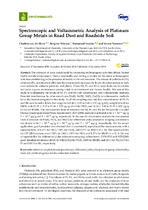| dc.description.abstract | The emission of toxic compounds by increasing anthropogenic activities affects human
health and the environment. Heavy road traffic and mining activities are the major anthropogenic
activities contributing to the presence of metals in the environment. The release of palladium
(Pd), platinum (Pt), and rhodium (Rh) into the environment increases the levels of contamination in
soils, road sediments, airborne particles, and plants. These Pd, Pt, and Rh in road dusts can be
soluble and enter aquatic environment posing a risk to environment and human health. The aim of
this study is to determine the levels of Pd, Pt, and Rh with spectroscopy and voltammetric methods.
Potential interferences by other metal ions (Na(I), Fe(III), Ni(II), Co(II)) in voltammetric
methods have also been investigated in this study. At all the sampling sites very low
concentrations of Pd, Pt, and Rh were found at levels that range from 0.48 ± 0.05 to 5.44 ± 0.11
ng/g (dry weight (d.wt)) for Pd(II), with 17.28 ± 3.12 to 81.44 ± 3.07 pg/g (d.wt) for Pt(II), and
14.34 ± 3.08 to 53.35 ± 4.07 pg/g (d.wt) for Rh(III). The instrumental limit of detection for Pd,
Pt, and Rh for Inductively Coupled Plasma Quadrupole-based Mass Spectrometry (ICP-QMS) analysis was
found to be 3 × 10−6 µg/g, 3 × 10−6 µg/g and 1 × 10−6 µg/g, respectively. In the case of
voltammetric analysis the instrumental limit of detection for Pd(II), Pt(II), and Rh(III) for
differential pulse adsorptive stripping voltammetry was found to be 7 × 10−8 µg/g, 6 × 10−8 µg/g,
and 2 × 10−7 µg/g, respectively. For the sensor application, good precision was obtained due to
consistently reproduced the measurements with a reproducibility of 6.31% for Pt(II), 7.58% for
Pd(II), and 5.37% for Rh(III) (n = 10). The reproducibility for ICP-QMS analysis were 1.58% for
Pd(II), 1.12% for Pt(II), and 1.37% for Rh(III) (n = 5). In the case of repeatability for
differential pulse adsorptive stripping voltammetry (DPAdSV) and ICP-QMS, good standard deviations
of 0.01 for Pd(II); 0.02 for Pt(II), 0.009 for Rh(III) and 0.011 for Pd, 0.019 for
Pt and 0.013 for Rh, respectively. | en_US |

